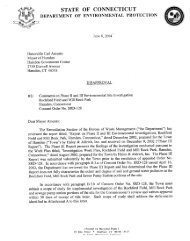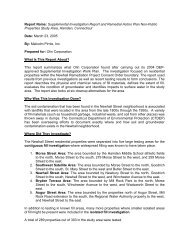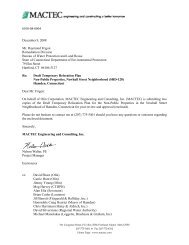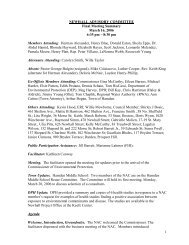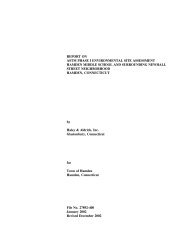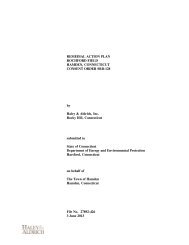Main Report - Newhall Remediation Project
Main Report - Newhall Remediation Project
Main Report - Newhall Remediation Project
- No tags were found...
You also want an ePaper? Increase the reach of your titles
YUMPU automatically turns print PDFs into web optimized ePapers that Google loves.
Exposure PathwaysTo evaluate potential exposures in the <strong>Newhall</strong> Street neighborhood, CT DPH considered theavailable environmental data and how people might come into contact with contaminants. Inorder for exposure to occur, there must be a source of hazardous contaminants, a way for peopleto come into direct contact with the contaminants, and a way for the contaminants to enter thebody. It is important to emphasize that if there is no exposure to a hazardous contaminant, thereis no risk of adverse health effects.In the <strong>Newhall</strong> Street neighborhood, contaminants have been detected in surface soil andsubsurface soil.Surface soilFor surface soil, possible ways people could be exposed to contamination is by ingestion (eatingsoil particles adhered to fingers or food items), dermal contact (skin contact with soil duringactivities such as gardening or other yard work, children playing in the soil) and inhalation(inhaling soil particles). In yard areas that are grassed or have other barriers to direct soil contact,such as asphalt, exposure potential to surface soils will be greatly diminished. For this PHA,exposure to contaminants in surface soils is considered to be a complete exposure pathway and isevaluated in more detail in the Public Health Implications section.Subsurface soilSubsurface soils in the neighborhood were also found to have contaminants. As summarized inTable 2, contaminant levels in soils at depth are significantly elevated above health-basedcomparison values. In the past, it is possible that neighborhood residents could have come intocontact with soils at depth during activities in their yards that penetrated into deep soils. Suchactivities could have included planting trees or shrubs and installing fence posts or footings for adeck. It is very difficult to quantitatively evaluate doses and health impacts to residents from pastexposure to soils at depth.Because contaminant levels in subsurface soils are high, CT DPH has conducted a number ofpublic health intervention activities to inform residents about the contamination and recommendways to avoid contact with subsurface soils. These interventions included home visits withresidents, preparing and distributing fact sheets, and presenting information at numerous publicmeetings and availability sessions. CT DPH continues to distribute its fact sheets and continuesto communicate its message about avoiding activities that penetrate into deep soils. Because ofCT DPH’s ongoing interventions, the current potential for exposure to soils at depth is very low.Therefore, CT DPH considers exposure to subsurface soils to be a potential exposure pathwayand it is not evaluated quantitatively in this Public Health Assessment.With regard to exposure pathways other than soil, air monitoring conducted during EPA’s soilexcavation work showed no airborne lead and the methane screening program found no evidenceof methane in the basements of homes in the neighborhood that were tested. Therefore, exposureto landfill waste materials through the air pathway (indoor air and outdoor air) is not likely.15



